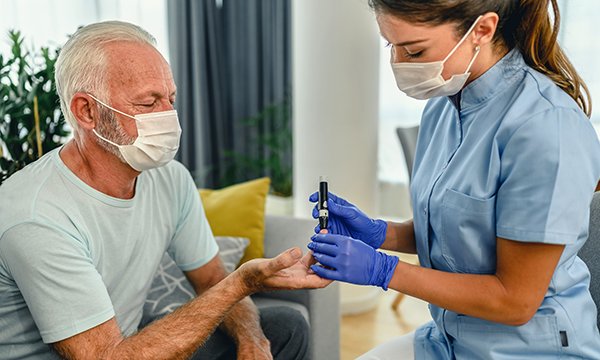Living with diabetes comes with its own set of challenges, and among the most serious complications is diabetic ketoacidosis (DKA). This life-threatening condition arises when the body doesn’t have enough insulin, causing blood sugar levels to spike and ketones to accumulate. In this blog, we will delve into the essential diabetic ketoacidosis treatment, exploring the first-line options and importantly, the recovery period. Whether you’re a diabetic individual, a caregiver, or simply seeking valuable information, join us on this journey to better comprehend DKA and learn how to respond promptly and effectively.
Contents
What Is Diabetic Ketoacidosis?
 Diabetic ketoacidosis (DKA) is a severe and potentially life-threatening complication that can occur in individuals with diabetes, particularly those with type 1 diabetes. It develops when the body faces a shortage of insulin, a hormone crucial for regulating blood sugar levels. Without enough insulin, cells cannot effectively utilize glucose for energy, prompting the body to break down fat for fuel. As fats are metabolized, ketones are produced. This further leads to an accumulation of these acidic substances in the bloodstream.
Diabetic ketoacidosis (DKA) is a severe and potentially life-threatening complication that can occur in individuals with diabetes, particularly those with type 1 diabetes. It develops when the body faces a shortage of insulin, a hormone crucial for regulating blood sugar levels. Without enough insulin, cells cannot effectively utilize glucose for energy, prompting the body to break down fat for fuel. As fats are metabolized, ketones are produced. This further leads to an accumulation of these acidic substances in the bloodstream.
The rising levels of ketones result in a state of ketoacidosis, characterized by an imbalance in the body’s pH levels. This acidic environment can have detrimental effects on various organs and systems. The onset of diabetic ketoacidosis is often rapid and can be triggered by factors like illness, infection, insufficient insulin dosage, or neglected diabetes management. Recognizing the early signs and seeking immediate medical attention is critical. Because untreated DKA can lead to severe complications, including organ failure and coma.
What Is The First Treatment For Diabetic Ketoacidosis?
The first-line treatment for diabetic ketoacidosis (DKA) involves administering insulin to address the underlying insulin deficiency and reduce the elevated blood sugar levels. Insulin is a hormone that enables cells to take up glucose from the bloodstream for energy. In the context of DKA, the body’s insulin deficiency leads to an inability of cells to use glucose. And, prompting the breakdown of fats and the production of ketones, resulting in an acidic state.
Typically, healthcare professionals administer insulin intravenously (IV) to ensure a rapid and precise response. The insulin infusion helps to lower blood sugar levels, halt the production of ketones, and shift the body’s metabolism away from fat breakdown. Intravenous fluids are administered to replenish fluids lost due to excessive urination and vomiting. Also, electrolytes are carefully monitored and supplemented as needed.
It’s important to note that the management of diabetic ketoacidosis is a complex process. Thus, treatment should be carried out in a medical setting, usually in a hospital. The specific insulin regimen and other interventions are tailored to the individual’s needs and closely monitored by healthcare professionals. This will help to ensure a safe and effective resolution of the DKA episode. Early recognition and prompt initiation of treatment are critical to prevent complications and improve outcomes.
What Are Some Effective Diabetic Ketoacidosis Treatment Options?
 Diabetic ketoacidosis (DKA) is a medical emergency that requires prompt and comprehensive treatment. The following are some effective diabetic ketoacidosis treatment options:
Diabetic ketoacidosis (DKA) is a medical emergency that requires prompt and comprehensive treatment. The following are some effective diabetic ketoacidosis treatment options:
Fluid Replacement
Dehydration is a common consequence of diabetic ketoacidosis (DKA) due to the excessive loss of fluids through frequent urination and vomiting. Intravenous (IV) fluid replacement is a critical component of DKA treatment, aimed at restoring fluid balance and preventing further dehydration. The choice of fluids is carefully considered, and saline solutions are often used to replenish lost fluids. The administration of fluids addresses dehydration. But also helps dilute the elevated blood sugar levels, contributing to the overall normalization of metabolic processes.
Electrolyte Management
DKA often leads to imbalances in electrolytes, including potassium, sodium, and chloride. Electrolyte abnormalities can have severe consequences, such as cardiac arrhythmias. Therefore, continuous monitoring and careful supplementation of electrolytes are essential in DKA treatment. Potassium levels, in particular, are closely watched, and potassium may be administered intravenously to maintain a balance between intra- and extracellular compartments. This meticulous management ensures the safe correction of electrolyte imbalances and reduces the risk of complications associated with abnormal electrolyte levels.
Monitoring and Correction of Acidosis
Acidosis is a hallmark of DKA, characterized by an imbalance in blood pH levels. Continuous monitoring of blood gases and pH is crucial, and interventions are tailored to correct acidosis. While sodium bicarbonate was traditionally used to address acidosis, its routine use is now limited and depends on the severity of the condition. Healthcare professionals carefully evaluate the patient’s acid-base status and consider the potential risks and benefits before administering bicarbonate, focusing on achieving a gradual and controlled correction of acidosis.
Identification and Treatment of Underlying Triggers
DKA is often precipitated by underlying factors such as infection, illness, or inadequate insulin dosage. Identifying and addressing these triggers are crucial steps in the treatment process. If infection is suspected, appropriate antibiotics are administered to target the causative agent. Addressing the root cause helps prevent the recurrence of DKA episodes. Ultimately, ensures a more comprehensive and successful treatment approach.
Continuous Monitoring and Adjustments
The effectiveness of DKA treatment relies on continuous monitoring of various parameters, including blood glucose levels, ketones, electrolytes, and acid-base balance. Healthcare professionals make real-time adjustments to insulin and fluid therapy based on ongoing assessments. This dynamic approach ensures that the treatment plan is tailored to the individual’s response. And, optimizing the chances of a successful resolution of the DKA episode while minimizing the risk of complications.
Medical Supervision and Hospitalization
Due to the complexity and potential severity of DKA, hospitalization is typically required for close medical supervision. In a hospital setting, healthcare professionals can closely monitor the patient’s condition, promptly intervene if complications arise, and adjust the treatment plan as needed. Hospitalization also provides an environment where specialized care can be delivered, contributing to the optimal management of DKA and a smoother recovery process.
Patient Education
Educating the individual about diabetes management is a key aspect of DKA treatment. Patients need to understand the importance of regular insulin use, recognizing early signs of DKA, and adopting lifestyle measures to prevent future episodes. Patient education empowers individuals to actively participate in their care. And, promoting long-term health and reducing the risk of recurrent DKA episodes.
It is crucial to emphasize that DKA is a serious condition requiring immediate medical attention. The treatment plan is individualized, and healthcare professionals closely monitor the response to interventions to achieve a successful resolution of the DKA episode. Early detection and intervention play a pivotal role in improving outcomes for individuals experiencing diabetic ketoacidosis.
What Is The Recovery Period For Diabetic Ketoacidosis?
 The recovery period for diabetic ketoacidosis treatment varies among individuals and depends on the severity of the episode, the effectiveness of the treatment, and any underlying factors contributing to the DKA. Typically, individuals with DKA begin to show improvement within the first 24 to 48 hours of treatment. As insulin therapy and fluid replacement address the underlying issues of insulin deficiency, hyperglycemia, and dehydration, the levels of ketones in the blood decrease, and acidosis is corrected.
The recovery period for diabetic ketoacidosis treatment varies among individuals and depends on the severity of the episode, the effectiveness of the treatment, and any underlying factors contributing to the DKA. Typically, individuals with DKA begin to show improvement within the first 24 to 48 hours of treatment. As insulin therapy and fluid replacement address the underlying issues of insulin deficiency, hyperglycemia, and dehydration, the levels of ketones in the blood decrease, and acidosis is corrected.
During this initial phase, close monitoring of blood glucose, electrolytes, and acid-base balance continues to guide adjustments in treatment as needed. Full recovery from DKA may take several days to a week. And, it often involves a gradual return to normal metabolic function. Hospitalization is common during the recovery period. This helps to ensure ongoing medical supervision and the ability to address any complications promptly.
Once stabilized, individuals may be transitioned to subcutaneous insulin therapy. Moreover, healthcare providers may work closely with patients to develop strategies for preventing future episodes of DKA. Patient education becomes a crucial component of the recovery process, focusing on diabetes management, lifestyle modifications, and the recognition of early signs of DKA to empower individuals in maintaining their health and preventing recurrence.
Conclusion
In conclusion, understanding diabetic ketoacidosis treatment is crucial for individuals with diabetes and their caregivers. DKA, a serious complication, requires immediate medical attention. From recognizing early symptoms to receiving prompt treatment in a hospital setting, the road to recovery involves insulin administration, fluid replacement, and careful monitoring of electrolytes. The recovery period varies. However, with proper care, individuals can start showing improvement within the first 24 to 48 hours.
Patient education on diabetes management and prevention is key for long-term well-being. Remember, early detection, timely intervention, and ongoing support are essential for navigating DKA successfully and reducing the risk of future episodes.
Do you want to get rid of diabetes? Join our online diabetes treatment program and reverse Diabetes naturally through lifestyle changes such as a Personalized Diet plan, Exercise, Yoga, dieticians, and health coaches.

